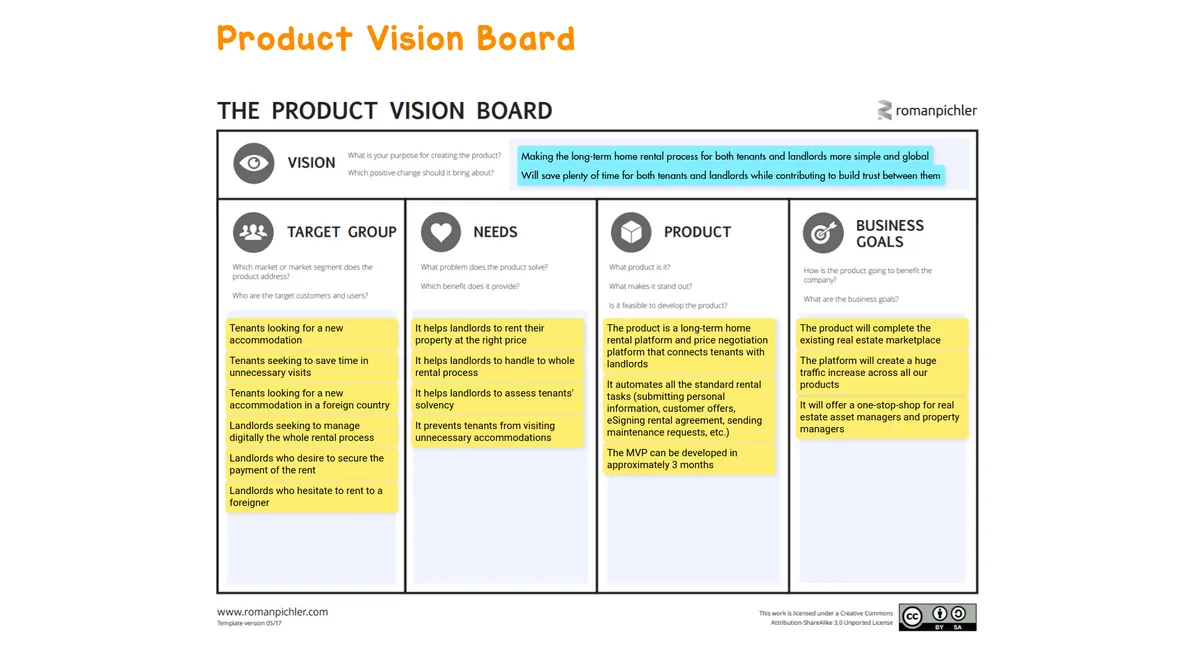What is the Product Vision Board?
Created by famous product management expert Roman Pichler, the Product Vision Board is designed to help product teams define their vision and establish a high-level strategy to guide the entire product development process. This canvas is divided into five key sections:
- Product Vision
- Target Customers
- Customer Needs
- Primary Product Features and Key Differentiators
- Business Goals (i.e. why should your organization invest in this product)
This strategic exercise forces both the development team and product stakeholders to agree on a single, unified strategy for bringing a product to life. Putting this vision down on “paper” creates greater team alignment at all stages of the product development process. It also provides an opportunity to address critical—but oftentimes neglected—questions like: How will this product positively impact the world? Why should our organization develop it? Why is it needed now?

Although the Product Vision Board workshop may seem quite formal at first, it has proven time and time again to be a necessary step for getting everyone on the same page. As part of the broader Agile process, the Product Vision Board is something that can be referenced from start-to-finish of the product development process, leaving opportunities to refine the vision and strategy as new or more data about the current market dynamics and needs of your target customers is collected.
Why is a compelling product vision necessary?
A product vision must be clear, concise, simple to remember, easy to repeat, and, most importantly, supported by everyone on the product team—including key business stakeholders. A well-defined product vision should ideally guide strategic decision-making, rally stakeholders, and give a greater sense of purpose to the entire product team.
Establishing a solid product vision is even more important in today’s predominantly VUCA (Volatile, Uncertain, Complex, and Ambiguous) leaning world. In many ways, it can serve as a ‘north star’ to help the product development team stay focused on building a product experience that addresses what really matters to target customers or end users.
Learn how to create a product vision in the Product Roadmap Example.
In this way, defining the product vision is an ideal opportunity to shine a spotlight on the key features that differentiate your product from the competition and underscore its relevance to your target customers in the here and now. When done well, this strategic exercise will fuel the broader product strategy, thereby giving the entire team a better way to make decisions that keep your product’s unique selling points and advantages top of mind at all times.
How to run a successful Product Vision Workshop
If you’ve never run a Product Vision Workshop before—or have only done so with varying levels of success—here are three tips for getting the most value out of them every time:
- Similar to the Lean Startup Canvas, it’s important to align your Product Vision to the unique needs of one—or perhaps a small handful of—target customer personas. Attempting to capture too many unrelated personas under one umbrella can quickly lead to the product not being able to satisfy the needs of any single customer segment. This will not lead to a successful product when all is said and done.
- In order to gauge how your target customers will respond to your product’s unique value proposition—as well as how much they would be willing to pay for the finished product—you need to step into their shoes and think about the product from their perspective. This involves gaining a deep understanding of the problems they face, giving you a strategic edge in building a product experience that squarely addresses their immediate problems or needs.
As a word of caution: Try not to confuse customer needs with product features while doing this exercise. Addressing customer needs is all about understanding the behaviors and motivations of your target customers. You should use that intelligence to inform the development of your feature set, as that is ultimately a response to those customer needs. But it’s not until you test your product features with real customers that you’ll know whether or not those features actually address those needs head on. You’ll always need to leave room for refinement. - You may be tempted to tackle a number of different goals during this workshop. While it’s not advised, if you do, be sure to prioritize them—and do whatever you can to keep your team focused on the product’s primary objective at all times. Not only will this lend itself to a more successful Product Vision Workshop overall, but it will also improve decision-making so that the product experience you build ultimately drives real and meaningful value for your target customers over the long term.
Suggested resources to go further
- Roman Pichler’s introduction The Product Vision Board exercise.
- An article by professional Scrum Trainer Robbin Schuurman: The Product Vision Board — A tool for creating your Product Vision.
- A video where Roman Pichler presents his Product Vision Board method: An Introduction to the Product Vision Board.
